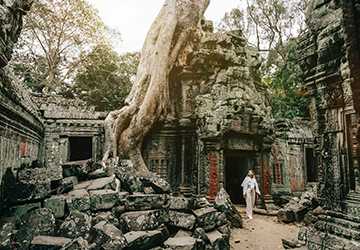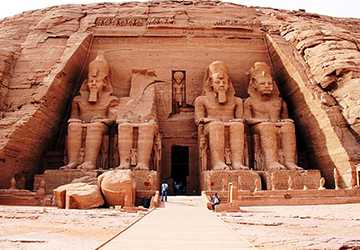The 10 Most Captivating Ancient Temples to Explore
A well-stocked wardrobe is essential to keep you looking your best. Certain pieces are necessary whether you are going to work, going out casually, or for a special occasion. A well-planned wardrobe can make choosing outfits easier and ensure you always look neat and presentable.
A well-stocked wardrobe is essential to keep you looking your best. Certain pieces are necessary whether you are going to work, going out casually, or for a special occasion. A well-planned wardrobe can make choosing outfits easier and ensure you always look neat and presentable.

Investing in these essential basics can save you time and stress while improving your style. Here are ten must-have clothing items for everyone that will add versatility, functionality, and timeless appeal to your everyday wear.
1. Angkor Wat, Cambodia
Angkor Wat is the world's largest religious monument in Siem Reap, Cambodia. It was initially built in the early 12th century as a Hindu temple dedicated to Vishnu and was gradually converted to a Buddhist temple. The temple complex is known for its stunning architecture, intricate carvings, and monumental size.
The 65-meter-tall central tower represents Mount Meru, the abode of the gods in Hindu mythology. The bas-reliefs at Angkor Wat depict various scenes from the Hindu epics Ramayana and Mahabharata.
2. Borobudur, Indonesia
Borobudur, in Central Java, Indonesia, is the largest Buddhist temple in the world. Built during the Sailendra dynasty in the 9th century, it consists of nine stacked platforms topped by a central dome. The temple is decorated with 2,672 reliefs and 504 Buddha statues. Its design symbolizes the path to enlightenment, with the central dome representing nirvana.
Visitors often wander through the temple's three levels, symbolizing the three realms of Buddhist cosmology: Kamadhatu, Rupadhatu, and Arupadhatu.
3. Karnak Temple, Egypt
The Karnak Temple complex in Luxor, Egypt, is one of ancient Egypt's largest and most important religious sites. Its development took about 2,000 years and was supported by contributions from successive pharaohs. The complex is primarily dedicated to the god Amun and includes temples dedicated to Mut and Montu.
The Hypostyle Hall has 134 massive columns and is one of the Karnak Temple's most iconic buildings. The temple walls are decorated with intricate hieroglyphics and reliefs depicting various gods and pharaohs.
4. Parthenon, Greece
The Parthenon on the Acropolis of Athens, Greece, symbolizes ancient civilization. He was born in the 5th century BC. It was built in 400 BC and dedicated to Athena, the goddess of wisdom and war. The Doric architecture of the Parthenon, characterized by its columns and friezes, is a model of the classical Greek style.
Inside is a vast gold-ivory statue of Athena. The temple's friezes and walls depict mythological scenes, including battles between gods and giants.
5. Temple of Heaven, China
The Temple of Heaven in Beijing, China, is a royal religious complex built in the early 15th century. Emperors of the Ming and Qing dynasties came here to pray for a good harvest. The temple's main buildings include the Hall of Prayer for Good Harvests, the Imperial Vault of Heaven, and the Yuanshan Altar.
The layout and design of the complex are based on symbolic cosmology, with the circle representing the sky and the square representing the earth.
6. Horyuji Temple, Japan
The Horyuji Temple in Nara, Japan, is one of the oldest temples and a UNESCO World Heritage Site. Founded by Prince Shotoku in 607, it is an essential site for understanding early Japanese Buddhism. The temple complex includes the world's oldest wooden structures, such as the five-story pagoda and the main hall (Kindo). Horyuji Temple is home to numerous cultural treasures, including statues, paintings, and religious artefacts that reflect the spread of Buddhism in Japan.
7. Abu Simbel, Egypt
Located on the western shore of Lake Nasser in southern Egypt, Abu Simbel consists of two massive rock temples built in the 13th century BC by the pharaoh Ramses II. The enormous temple is dedicated to Ramses II and features four colossal pharaoh statues at the entrance. Smaller temples are devoted to his wife, Queen Nefertari, and the goddess Hathor.

The temples were relocated in the 1960s to protect them from rising water levels from the Aswan High Dam. The interior walls are decorated with scenes of the pharaoh's victory and offerings to the gods.
8. Prambanan, Indonesia
Located in central Java, Indonesia, Prambanan is an impressive Hindu temple complex dedicated to three gods: Brahma, Vishnu, and Shiva. Built-in the 9th century, the temple features several soaring towers, including a 47-meter-tall central Shiva temple. The temple complex is known for its detailed carvings depicting scenes from the Ramayana and other Hindu stories. Prambanan's architectural style and craftsmanship reflect the pinnacle of Indonesian Hindu culture.
9. Wat Phra Kaew, Thailand
The Temple of the Emerald Buddha (Wat Phra Kaew), also known as the Temple of the Emerald Buddha, is located within the Grand Palace complex in Bangkok, Thailand. It is considered the most sacred Buddhist temple in Thailand. The temple houses the Emerald Buddha, a revered statue carved from a single piece of jade. The temple's architecture features intricate murals, golden stupas, and detailed decoration. Wat Phra Kaew is an essential venue for royal ceremonies and religious practices in Thailand.
10. Meenakshi Amman Temple, India
The Meenakshi Amman Temple in Madurai, Tamil Nadu, India, is a historic Hindu temple dedicated to the goddess Meenakshi (Parvati) and her consort Sundareswara (Shiva).
The temple complex covers an area of 14 hectares and includes 14 towering gopurams (gate towers) decorated with thousands of colourful sculptures depicting gods, goddesses, and mythical creatures. Temple halls like the Thousand Pillars Hall display exquisite stone carvings and vivid artwork.
Conclusion
Exploring ancient temples offers a unique journey through history, culture and spirituality. Each temple reflects its civilization's beliefs, artistic achievements and architectural advancements. Whether it is the grand scale of Angkor Wat, the intricate carvings of Prambanan or the sacred atmosphere of the Emerald Buddha Temple, these sites have a deep connection to the past.
They are cultural landmarks that inspire awe and reverence in visitors from all over the world. So pack your bags, embark on an adventure, and immerse yourself in the timeless splendour of these magnificent temples.